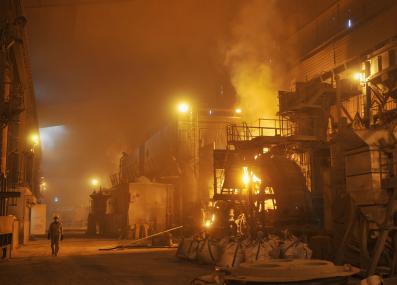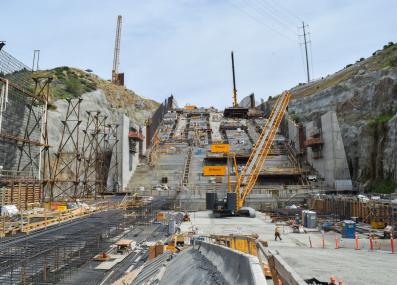Have a question?
Which industries contribute most to climate change?
The steel, cement, chemicals, agriculture, textiles and of course energy industries are all major emitters of climate-warming greenhouse gases—but the headline numbers don’t tell the whole story.
March 6, 2025
In 2023, humanity put over 40 billion tons of planet-warming carbon dioxide (CO2) into the atmosphere.1 That CO2 gets into the air in thousands of different ways, large and small. But a few industries do stand out, contributing to climate change as much as major countries.
The fertilizer industry produces around 2% of humanity’s climate-warming emissions:2 about as much as Japan.3 Shipping,4 plastics,5 and aviation6 each account for around 3% of climate change, in the same neighborhood as Brazil. The chemicals industry, at 5% of emissions,7 is about the same size as Russia, while steel and iron (7%),8 concrete (8%),9 and the fashion industry (another 8%)10 all warm the planet as much as India. Agriculture’s 17% outstrips the entire United States,11 and the building sector, at an astonishing 37%, leaves behind even China.12
If you’ve been counting along, that adds up to nearly 100%—and we haven’t even mentioned cars, trucks or electricity. How is that possible?
“One needs to be careful adding such numbers,” explains Sergey Paltsev, Deputy Director of the MIT Center for Sustainability Science and Strategy. “Some of them are reported as a percent of CO2 emissions, and others as a percent of all greenhouse gases.” Some studies are strict about only counting emissions from direct manufacturing processes, and others are expansive, looking at all the energy and materials the industry buys and sells. “In general, you cannot add these numbers up for all industries, because you're going to do double counting.”
Take the ways the fashion industry contributes to climate change. Clothes are made from textiles, which are either natural fibers like cotton (from agriculture), or synthetics (from the plastics industry—itself a subset of the chemicals industry). Clothes are also transported around the world, adding emissions from shipping and aviation.
This double- and triple-counting only gets worse once we rope in the energy industry. You could say, reasonably enough, that fossil fuel companies are by far the biggest contributors to climate change, since over 90% of our CO2 emissions come from burning coal, oil and gas.1 But you could just as easily assign the climate impact to the users of those fuels: perhaps the utilities burning coal to make electricity, or the fashion industry again, buying that electricity to power its factories. “An oil company will have its own emissions while they are doing exploration, or while they are refining oil,” says Paltsev. “But the majority of their emissions are going to be somebody else’s emissions, further down the supply chain.”
In tackling these emissions, researchers and policymakers can find better information by closely studying how an industry contributes to climate change, rather than just asking how much.
For example: how wide a view of the “industry” do you want to take? Consider aluminum (about 2% of global emissions),13 which relies on mining bauxite ore. “There are emissions from material extraction, there are emissions from the machinery which is used for material extraction, there are emissions in the production of that machinery,” says Paltsev. “It really depends on where you are drawing the boundary, and that's somewhat arbitrary.”
Some of these steps are clearly in the industry’s control: how is raw ore turned into usable metal? But some may be better addressed by others. It’s fair enough to count the manufacturing of mining equipment as part of the climate cost of aluminum, but that’s not a problem most of us would expect an aluminum company to solve.
You could also ask which emissions are quickest and easiest to get rid of. “There are some so-called hard-to-abate sectors that are sizable, like cement, steel, chemicals, fertilizers,” says Paltsev. In addition to using large amounts of energy, what they have in common is unique ways of creating CO2: it’s a byproduct of the chemistry that turns iron into steel, for example, or that forms the basic building blocks of plastics. These industries need entirely new manufacturing processes to zero out their climate pollution.
Meanwhile, other industries have common challenges with off-the-shelf solutions. Around half the emissions from the building sector come just from electricity—a much softer target.12 “The cost of addressing electricity is much smaller in comparison to addressing, say, the cement industry,” Paltsev says, “because we already have good opportunities with wind and solar, and some useful developments in other energy technologies.”
Finally, if you want to compare industries, it’s important to spot how one study might differ from another. Look under the hood of the concrete industry, for example, and you may find it’s being credited with 8% of CO2 emissions8—while agriculture is responsible for 17% of all climate-warming greenhouse gases.11 That’s a huge distinction, because CO2 only drives about 75% of climate change today.14 “We are so focused on CO2 that we sometimes forget about rice production, about meat consumption,” says Paltsev. “And those are big contributors to greenhouse gas emissions, but typically they're methane, not CO2.”
If all you want is a headline number to call attention to a certain industry, this may sound like picking nits. But in the hunt for solutions, the details of how our climate pollution enters the atmosphere are far more important than which industries get the blame. When our children and grandchildren are adults, we’d like them to still have ships and building materials and clothing—just without destabilizing the climate they depend on.
“The goal is not to ban any industry,” says Paltsev. “The goal is to reduce emissions, and those are different things.”
Thank you to Luke Koester of Clinton, Iowa, for the question.
Submit your own question to Ask MIT Climate
Get the latest from Ask MIT Climate monthly in your inbox
1 Friedlingstein, Pierre, et al., "Global Carbon Budget 2023." Earth System Science Data, Volume 15, Issue 12, 2023, doi:10.5194/essd-15-5301-2023.
2 Menegat, Stefano, Alicia Ledo, and Reyes Tirado, "Greenhouse gas emissions from global production and use of nitrogen synthetic fertilisers in agriculture." Nature Scientific Reports, Volume 12, 2022, doi:10.1038/s41598-022-18773-w.
3 This and all subsequent national emissions figures from the EDGAR (Emissions Database for Global Atmospheric Research) Community GHG Database: Crippa, Monica, et al., "GHG emissions of all world countries," Publications Office of the European Union, Luxembourg, 2024, doi:10.2760/4002897.
4 International Maritime Organization: "Fourth IMO Greenhouse Gas Study," 2021.
5 Organization for Economic Cooperation and Development: "Global Plastics Outlook: Economic Drivers, Environmental Impacts and Policy Options," 2022.
6 Lee, D.S., et al., "The contribution of global aviation to anthropogenic climate forcing for 2000 to 2018," Atmospheric Environment, Volume 244, 2021, doi:10.1016/j.atmosenv.2020.117834.
7 Gabrielli, Paolo, et al., "Net-zero emissions chemical industry in a world of limited resources," One Earth, Volume 6, Issue 6, 2023, doi:10.1016/j.oneear.2023.05.006.
8 International Energy Agency: "Iron and Steel Technology Roadmap," 2020.
9 Andrew, Robbie, "Global CO2 emissions from cement production, 1928–2018," Earth System Science Data, Volume 11, Issue 4, doi:10.5194/essd-11-1675-2019.
10 Quantis: "Measuring Fashion: Environmental Impact of the Global Apparel and Footwear Industries Study," 2018.
11 Food and Agriculture Organization of the United Nations: "Emissions due to agriculture: Global, regional and country trends 2000–2018," 2020.
12 United Nations Environment Programme: "Building Materials and the Climate: Constructing a New Future," 2023.
13 World Economic Forum: "Aluminium for Climate: Exploring pathways to decarbonize the aluminium industry," 2020.
14 Jones, Matthew, et al., "National contributions to climate change due to historical emissions of carbon dioxide, methane and nitrous oxide," EU Open Research Repository, 2024, doi:10.5281/zenodo.7076346.








